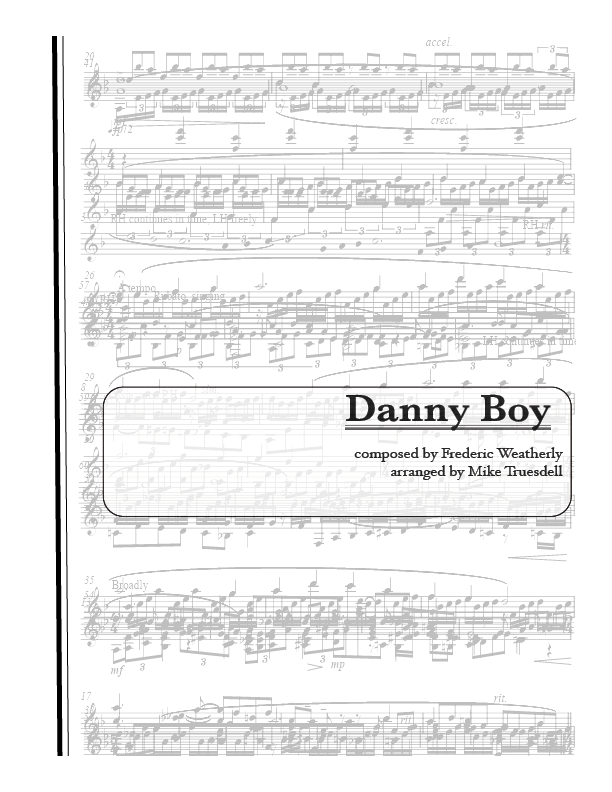
Danny Boy
Composed by Frederic Weatherly
Arranged for Solo Vibraphone by Mike Truesdell
Origin story:
In late 2016, The Discovery Orchestra asked me to perform a solo recital featuring the vibraphone. We settled upon the date March 17, 2017 as the date of my recital, which is St. Patrick’s Day!
An important part of my recital programming process is to achieve a diverse program in multiple ways, including stylistic. I wanted to have a ballad piece on the program, and Danny Boy was a perfect fit for the St. Paddy’s Day holiday. I searched for vibraphone solo arrangements of this stunning melody and came up empty. So, my next step was to make my own!
My next step was to transcribe the melody and harmony and listen to as many different performances as I possibly could. I learned from this listening and my own musical tastes a few things:
I wanted sacred feeling to the opening and closing sections (not a specific religion, necessarily, but a sacred feel)
Goals were pastoral, open, lush
Pastoral = never rushed, fluid
Open = spacing between hands, voicings that use 5ths and octaves
Lush = upper-extensions in the harmonies, closed voicings
So I set to work!
Process
Melody and harmony:
I first started with writing the melody and chord symbols on the page. I played through different upper extensions to the chords to see which ones fit and which ones didn’t (aka a b9 on a tonic major chord was not the sound I was going for here).
For the harmony, I didn’t always use the upper extension notes, but I wanted to know which extra notes were an option.
**Disclaimer: I have not much formal jazz harmony training, so a lot of this step would have been much easier if I paid attention better in Fred Sturm’s classes…
Texture
I played just the melody and simple chords and asked myself, “Is that enough?”. If yes, then I left it. If not, I would slowly add one note at a time.
I didn’t want to put anything in the piece that wasn’t necessary.
I like the narrative that I tried to tell with the texture.
First is the open fifths and the main character sings with bells ringing
Next is two voices singing together
Then the melody stays clearly on top and there is movement as the main character moves back from the hills
The main character hears the ringing of bells in the distance, and
Then the whole city is singing the melody together
Finally the main character hums to themselves once again while the bells ring again.
Of course come up with your own narrative, but I tried to tell this one through texture.
Form
I knew I wanted the melody to be clear the whole time I was playing. This is one of the greatest melodies and I wanted the audience to be able to follow the tune clearly.
I wanted movement in the piece without sacrificing the speed of the melody, so I increased the subdivision to create that movement. After listening back now I think that the form of slow melody and then keeping the melody a similar tempo while changing the accompaniment speed is inspired by Colors of the Wind from Pocohontas.
My “take” (what I did in the arrangement)
I attempted to showcase different textures available with four mallets
I wanted to show the full range of the vibraphone
Harmony and chromatic passing tones were exploited heavily in this arrangement, much to my joy.
The most important part of this is that the arrangement should make people happy! It is such a beautiful tune and I wanted to be a part of the legacy of this piece without too much shame!
